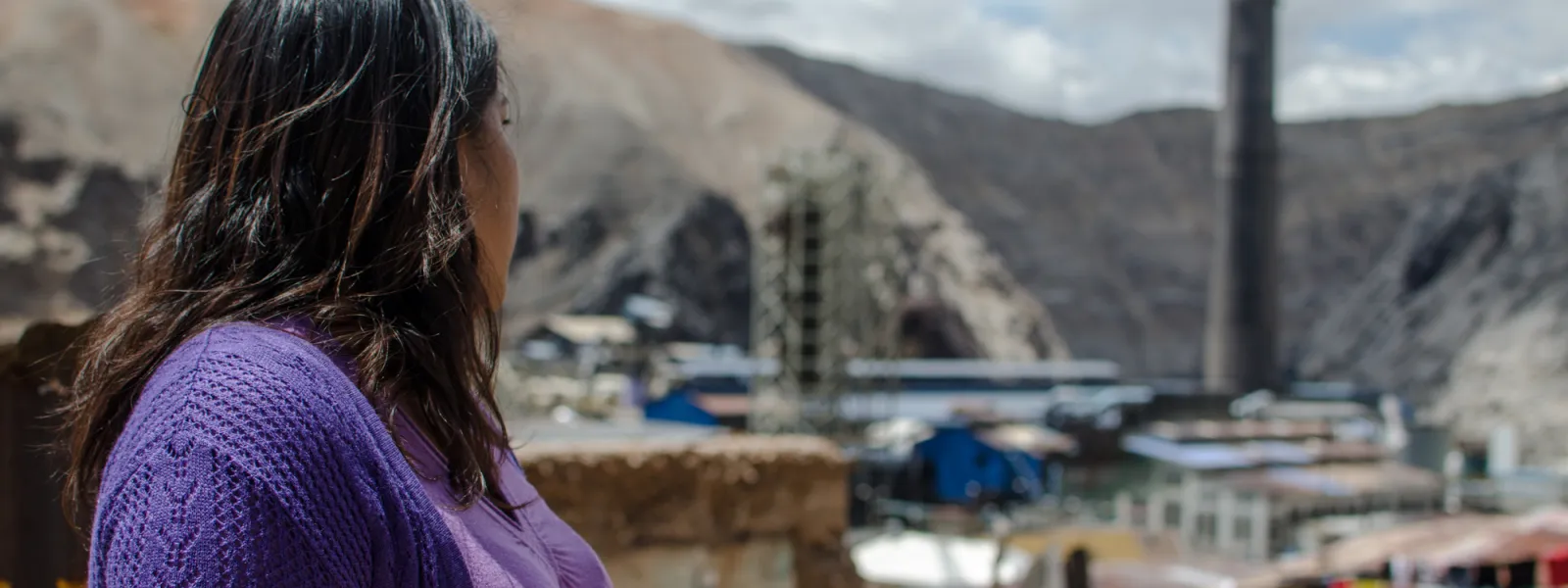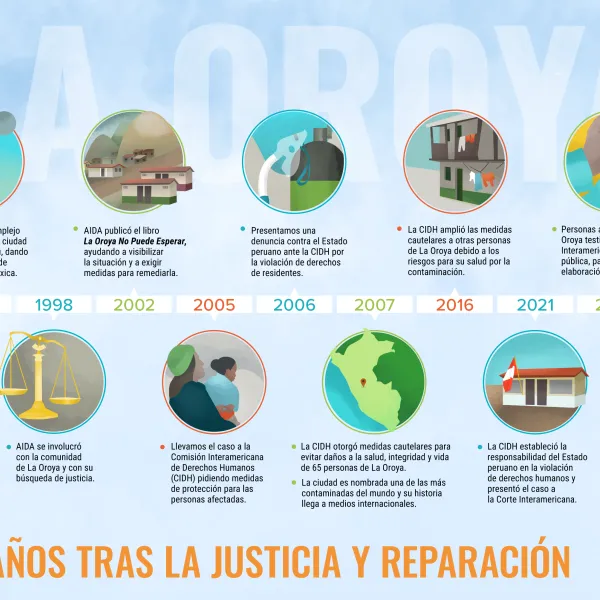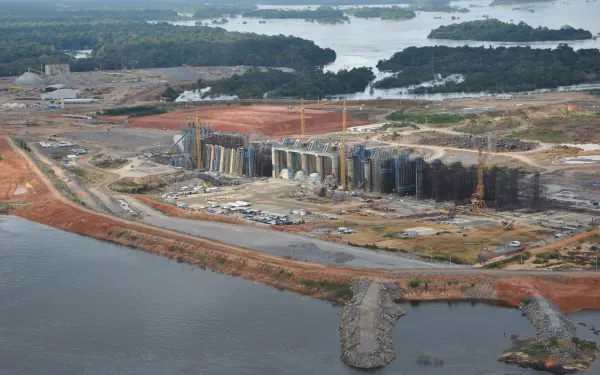
Project
Protecting the health of La Oroya's residents from toxic pollution
For more than 20 years, residents of La Oroya have been seeking justice and reparations after a metallurgical complex caused heavy metal pollution in their community—in violation of their fundamental rights—and the government failed to take adequate measures to protect them.
On March 22, 2024, the Inter-American Court of Human Rights issued its judgment in the case. It found Peru responsible and ordered it to adopt comprehensive reparation measures. This decision is a historic opportunity to restore the rights of the victims, as well as an important precedent for the protection of the right to a healthy environment in Latin America and for adequate state oversight of corporate activities.
Background
La Oroya is a small city in Peru’s central mountain range, in the department of Junín, about 176 km from Lima. It has a population of around 30,000 inhabitants.
There, in 1922, the U.S. company Cerro de Pasco Cooper Corporation installed the La Oroya Metallurgical Complex to process ore concentrates with high levels of lead, copper, zinc, silver and gold, as well as other contaminants such as sulfur, cadmium and arsenic.
The complex was nationalized in 1974 and operated by the State until 1997, when it was acquired by the US Doe Run Company through its subsidiary Doe Run Peru. In 2009, due to the company's financial crisis, the complex's operations were suspended.
Decades of damage to public health
The Peruvian State - due to the lack of adequate control systems, constant supervision, imposition of sanctions and adoption of immediate actions - has allowed the metallurgical complex to generate very high levels of contamination for decades that have seriously affected the health of residents of La Oroya for generations.
Those living in La Oroya have a higher risk or propensity to develop cancer due to historical exposure to heavy metals. While the health effects of toxic contamination are not immediately noticeable, they may be irreversible or become evident over the long term, affecting the population at various levels. Moreover, the impacts have been differentiated —and even more severe— among children, women and the elderly.
Most of the affected people presented lead levels higher than those recommended by the World Health Organization and, in some cases, higher levels of arsenic and cadmium; in addition to stress, anxiety, skin disorders, gastric problems, chronic headaches and respiratory or cardiac problems, among others.
The search for justice
Over time, several actions were brought at the national and international levels to obtain oversight of the metallurgical complex and its impacts, as well as to obtain redress for the violation of the rights of affected people.
AIDA became involved with La Oroya in 1997 and, since then, we’ve employed various strategies to protect public health, the environment and the rights of its inhabitants.
In 2002, our publication La Oroya Cannot Wait helped to make La Oroya's situation visible internationally and demand remedial measures.
That same year, a group of residents of La Oroya filed an enforcement action against the Ministry of Health and the General Directorate of Environmental Health to protect their rights and those of the rest of the population.
In 2006, they obtained a partially favorable decision from the Constitutional Court that ordered protective measures. However, after more than 14 years, no measures were taken to implement the ruling and the highest court did not take action to enforce it.
Given the lack of effective responses at the national level, AIDA —together with an international coalition of organizations— took the case to the Inter-American Commission on Human Rights (IACHR) and in November 2005 requested measures to protect the right to life, personal integrity and health of the people affected. In 2006, we filed a complaint with the IACHR against the Peruvian State for the violation of the human rights of La Oroya residents.
In 2007, in response to the petition, the IACHR granted protection measures to 65 people from La Oroya and in 2016 extended them to another 15.
Current Situation
To date, the protection measures granted by the IACHR are still in effect. Although the State has issued some decisions to somewhat control the company and the levels of contamination in the area, these have not been effective in protecting the rights of the population or in urgently implementing the necessary actions in La Oroya.
Although the levels of lead and other heavy metals in the blood have decreased since the suspension of operations at the complex, this does not imply that the effects of the contamination have disappeared because the metals remain in other parts of the body and their impacts can appear over the years. The State has not carried out a comprehensive diagnosis and follow-up of the people who were highly exposed to heavy metals at La Oroya. There is also a lack of an epidemiological and blood study on children to show the current state of contamination of the population and its comparison with the studies carried out between 1999 and 2005.
The case before the Inter-American Court
As for the international complaint, in October 2021 —15 years after the process began— the IACHR adopted a decision on the merits of the case and submitted it to the Inter-American Court of Human Rights, after establishing the international responsibility of the Peruvian State in the violation of human rights of residents of La Oroya.
The Court heard the case at a public hearing in October 2022. More than a year later, on March 22, 2024, the international court issued its judgment. In its ruling, the first of its kind, it held Peru responsible for violating the rights of the residents of La Oroya and ordered the government to adopt comprehensive reparation measures, including environmental remediation, reduction and mitigation of polluting emissions, air quality monitoring, free and specialized medical care, compensation, and a resettlement plan for the affected people.
Partners:

Related projects
Indigenous and Riverbank Communities Call on the Inter-American Commission on Human Rights to Suspend the Massive Belo Monte Dam in the Brazilian Amazon
FOR IMMEDIATE RELEASE November 11, 2010 Media Contacts: Astrid Puentes, AIDA - +1 510 984 4610, [email protected] Andressa Caldas, Justiça Global: +55 21 2544 2320 / 21 8187 0794, [email protected] Renata Pinheiro, Xingu Alive Forever Movement: + 55 93 9172 9776, [email protected] Christian Poirier, Amazon Watch: +1 510-666-7565, [email protected] As the government prepares to issue the dam’s construction license, communities urge the Commission to denounce illegalities in licensing and violations of human rights Washington, D.C., Brazil- Today international and Brazilian human rights and environmental organizations submitted a formal petition to the Inter-American Commission on Human Rights (IACHR), denouncing grave and imminent violations upon the rights of indigenous and riverine communities that will be affected by the construction of Belo Monte Dam Complex on the Xingu River in the Brazilian Amazon. Signed by the Xingu Alive Forever Movement as well as the representatives of affected communities – the Conselho Indigenista Missionário (CIMI), Coordenação das Organizações Indígenas da Amazônia Brasileira (COIAB), Prelazia do Xingu, Sociedade Paraense de Direitos Humanos (SDDH), Justiça Global, and the Interamerican Association for Environmental Defense (AIDA) – with the support of over twenty organizations and social movements, the petition urgently calls on the Commission to adopt “precautionary measures” that would compel the Brazilian government to halt plans to build the dam, slated to be world’s 3rd largest. The petition documents the Brazilian government’s violation of international treaties, ignoring the fundamental rights of indigenous peoples from the lower Xingu Basin, including the Arroz Cru, Arara da Volta Grande, Juruna do Km 17 and Ramal pas Penas communities. It also highlights major threats posed by the Belo Monte Dam, including forced displacement of communities without insuring their free, prior and informed consent, threats to food security and access to drinking water. “The government claims that the Juruna will not be affected, but we do not believe this. We have not been consulted and we do not want the government to speak for us,” said Sheyla Juruna, member of a Juruna indigenous community that will be affected by Belo Monte. “We are against the Belo Monte Dam and we are committed to fight with our bodies and souls to defend our lives and the life of our river.” The IACHR petition comes on the same week as prosecutors from Brazil’s Federal Public Ministry (MPF) sent a document to Brazil’s environmental agency IBAMA advising that the agency not issue an installation license until the dam-building consortium Norte Energia can comply with an obligatory set of social and environmental conditions. Norte Energia and the Brazilian government have been pushing IBAMA to issue a “partial” installation license, which would allow the project to break ground without complying with legally binding conditions on the dam’s provisional license. Based on assessments from government agencies – like IBAMA [Brazil’s environmental agency] and the Federal Public Ministry – and those from groups of specialists, the organizations affirm that the construction of Belo Monte will increase illness and poverty, while causing a surge of disorderly migration to the region that will overload health, education, and public safety infrastructure. The petition concludes: "Despite the gravity and irreversibility of the impacts of the project to local communities, there were no appropriate measures taken to ensure the protection of human rights and the environment." “It worries us how the Brazilian government is ignoring national and international standards to accelerate this project, even at the expense of human rights and the environment,” affirmed Astrid Puentes Riaño, the co-Director of the Interamerican Association for Environmental Defense (AIDA). “Moving forward without taking precautions required by international norms will only result in human rights violations and the irreversible destruction of a critically important region of the Amazon.” In addition to calling attention to the illegalities and human rights violations associated with the Belo Monte Dam, the petition cites an important precedent, pointing out that in 2009 the IACHR implemented similar precautionary measures, leading to the suspension of the Chan-75 hydroelectric dam in Panama due to possible violations of indigenous communities’ rights. ### For more information on the Belo Monte Dam, visit: http://xingu-vivo.blogspot.com http://www.aida-americas.org http://www.internationalrivers.org http://amazonwatch.org /
Read more
Large dams in the Americas: Is the cure worse than the disease?
Large dams consistently cause severe, and often irreversible, environmental and social damage. Their construction is also often associated with violations of international human rights and environmental laws. AIDA’s report Large Dams in the Americas: Is the Cure Worse than the Disease? explores these grave impacts and explains the existing international standards that should be applied to protect the environment and human rights. The report also exposes the dangers of using large hydroelectric dams to meet increasing energy demands in Latin America. To promote greater protection of human rights, AIDA gave testimony based on this dams report to the Inter-American Commission on Human Rights (IACHR) at a general hearing on November 2, 2009. AIDA has also shared the report’s findings with international experts, policymakers, non-governmental organizations, affected local communities, and international financial institutions such as the World Bank and the Inter-American Development Bank. Furthermore, AIDA staff presented legal strategy workshops at "Rivers for Life 3", an international meeting of dam-affected communities in Temacapulín, Mexico, October 1-7, 2010. The previous month, AIDA staff represented Latin America on a panel of water experts at World Water Week in Stockholm. In Large Dams in the Americas, AIDA examines five large hydroelectric dams in violation of a range of environmental and human rights laws: Yacyretá in Argentina and Paraguay, Río Madeira in Bolivia and Brazil, Baba in Ecuador, Chan-75 in Panama, and La Parota in Mexico. Through these case studies, AIDA illustrates how governments generally disregard important international obligations and standards, such as the need to conduct proper environmental and social impact assessments. In the report, we also explain the significant social and environmental impacts caused by large dams. We discuss how families suffer when they are displaced or forcefully evicted by dams and lose valuable farmland, water sources, or traditional fishing areas. We document how the people most harmed by large dams are those from vulnerable populations, including indigenous, afro-descendent and poor farming communities. We also describe how large dams typically harm the environment by flooding valuable ecosystems, dramatically altering natural flows of water, disrupting wildlife habitat, and obstructing the migratory paths of perse species, among other impacts. In addition, Large Dams in the Americas dispels the myth that dams are a source of "green energy". Even though dams do not rely on fossil fuels to generate electricity, they still contribute to greenhouse gas emissions. Hydroelectric dams create enormous reservoirs of river water that submerge valleys and lead to the decomposition of vast amounts of organic matter. As the trees and other biomasses break down, they release carbon dioxide and methane, the same greenhouse gases that are created by "dirty" technologies like coal-fired electricity plants. Turbines also liberate methane trapped in deep water and emit carbon dioxide as they release pressure from the reservoir. In tropical regions, dams can emit as much as eleven times the amount of greenhouse gases that a conventional power plant of equivalent size would emit. Given the negative impacts of large dams, AIDA's report recommends that policymakers seriously consider alternatives that protect human rights and our natural ecosystems, save energy, and reduce greenhouse gas emissions. Suggested alternatives include: improving energy efficiency, reducing demand, making better use of sustainable energy sources, investing in energy-efficient technologies and infrastructure, and removing barriers that hinder technology exchange between nations. AIDA wrote this report in collaboration with our participating organizations, CEMDA, CEDHA, ECOLEX and Earthjustice, as well as International Rivers, Sobrevivencia, and the Association for Conservation and Development (ACD). By educating governments, policymakers, communities, and other key players about large dams, we seek to encourage authorities to investigate the matter and apply our recommendations on how to implement dam projects in compliance with international laws. Spanish-Language Report Available Here
Read more
AIDA calls on financial institutions to join the fight against climate change
International Financial Institutions (IFIs) have a significant influence on large infrastructure projects and energy development in the western hemisphere. Many of them finance projects that accelerate climate change. These include large dams that emit methane gas, mines that disturb carbon sinks, and power plants that inefficiently use highly polluting coal- and oil-based technologies. This financing, for example, is behind “La Colosa,” a huge gold mining project in Colombia. The project could affect the paramos and release the huge amounts of carbon dioxide retained by these high-altitude wetlands. The Inter-American Development Bank (IDB), the World Bank Group (WBG) and its member institution, the International Finance Corporation (IFC), recently carried out research to redesign their energy investment strategies. AIDA took part in this process, pressing the IFIs to prioritize the development of clean and sustainable energy sources. We urged them to: Consider climate change and human rights in every stage of the process; Incorporate the highest standards of human rights, social equity, energy efficiency and natural resource planning in decisions; Set aggressive but achievable targets for reducing carbon dioxide emissions for the projects they support; and Prioritize energy efficiency and renewable energies while also discouraging a continued dependence on fossil fuels. AIDA also participated in the public consultation at which the IDB was called on to give comments on the current policy of the Independent Consultation and Investigation Mechanism (ICIM). While not perfect, the ICIM is the only grievance system available to people affected by activities funded by the institution. AIDA, together with other organizations in the region, sent a letter with the comments, which was a great opportunity to increase the transparency, accountability and effectiveness of the mechanism. Along with the IDB and the institutions of the World Bank Group, there is the National Development Bank of Brazil (BNDES), which, although not officially an IFI, behaves as such and wields a huge influence in the region. It has amassed such financial power to allow it expand outside its borders and participate in large investment projects in more than 11 countries in Latin America. The concern is that BNDES doesn’t have socio-environmental safeguards or transparency and participation policies in line with its size and influence. Instead, it is governed by much lower standards than the IFIs working in the region. BNDES doesn’t have mechanisms to ensure the protection of the environment and communities affected by the projects it finances, nor does it have an effective system for addressing complaints or claims. In fact, the projects supported by BNDES have been drawing attention from environmentalists and human rights defenders in the region for years. We have focused much of our work on influencing this organization so it will promptly implement appropriate environmental and social policies. What is interesting and encouraging is that we’re not alone in this task. In November 2012, we created a coalition called “BNDES na Mira,” which brings together over 90 people from more than 25 organizations in the region. The group is a reflection of the need to work together to achieve ambitious and needed results. At the same time and as part of the ongoing training of our team and the group in general, we are developing a report to explain the inner workings of BNDES so that we can understand their decision-making process and pressure points. We also hope to make contacts to help us have an impact in and outside the bank. To address BNDES’ lack of recognition as an IFI and hence its need to comply with the responsibilities that entails, AIDA is working on a third document that will develop this argument and provide a comparison between the safeguard and transparency policies of BNDES and other IFIs working in the region such as the World Bank and the IDB. Also as part of “BNDES na Mira,” we participate in workshops and seminars to further strengthen our joint work, share information and develop common strategies for the future and a possible long-term channel of communication with representatives of the bank. Given the huge amounts of money that IFIs and BNDES provide to projects and programs around the continent, any influence that we can have on their policymaking can lead to significant reductions in the emissions that cause climate change. These institutions have the opportunity to choose new tools to redirect their path toward truly sustainable development, and therefore to help protect our health and the environment from climate change. AIDA will continue examining and influencing the IFIs and BNDES on a constant basis and especially during their process of reshaping internal policies.
Read more